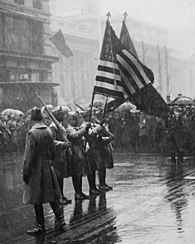| John Hanks Alexander | |
|---|---|
 From 1900's A New Negro for a New Century: An Accurate and Up-to-Date Record of the Upward Struggles of the Negro Race. From 1900's A New Negro for a New Century: An Accurate and Up-to-Date Record of the Upward Struggles of the Negro Race. | |
| Born | (1864-01-06)January 6, 1864 Helena, Arkansas |
| Died | March 26, 1894(1894-03-26) (aged 30) Wilberforce, Ohio |
| Buried | Cherry Grove Cemetery, Xenia, Ohio |
| Allegiance | |
| Service | |
| Years of service | 1887–1894 |
| Rank | |
| Unit | 9th Cavalry Regiment |
| Battles / wars | Indian Wars |
John Hanks Alexander (January 6, 1864 – March 26, 1894) was the first African-American officer in the United States armed forces to hold a regular command position and the second African-American graduate of the United States Military Academy (after Henry Ossian Flipper).
Early life
John Hanks Alexander was born on January 6, 1864, at Helena, Arkansas, the fourth of seven children born to former slaves James Milo Alexander and Fannie Miller Alexander. James Alexander was a barber and dry goods salesman in Helena and acquired property there. He later became the first black Justice of the Peace in Arkansas and represented Phillips County in the Arkansas House of Representatives. He died in 1871. All of the Alexander children graduated from high school and three attended Oberlin College in Ohio.
Alexander graduated number one in his high school class in Helena and soon moved to Carrollton, Mississippi, to take a position as a teacher. In late 1880 he visited his uncle in Cincinnati, Ohio, and ended up remaining in that city. The next year, he enrolled at Oberlin College and attended that institution until passing the entrance examination for West Point in 1883. Alexander was sponsored by Democratic U.S. Rep. George W. Geddes of Ohio.
Military career

Alexander's experience at West Point is disputed. Some accounts suggest Alexander was generally accepted by the other cadets and was not subjected to as much intolerance as previous black cadets. Adjutant Eli Hoyle described Alexander as "a splendid scholar, getting along finely". Other accounts suggest he spent his early years at the academy in "social isolation", where he suffered from racial slurs and exclusion from extracurricular activities. At West Point, he was not allowed to room with white cadets, and would routinely be ignored while attending Sunday Chapel.
All accounts indicate that Alexander was known as an excellent student, especially in mathematics and languages and was a skilled boxer while at the academy. He distinguished himself as a skilled rider when performing in the cavalry drill. He graduated in the class of 1887 ranking 32nd in a class of 64.
Alexander was assigned to the 9th US Cavalry Regiment at Fort Robinson, Nebraska, which was an all-black regiment commanded by white officers and nicknamed Buffalo soldiers. In 1888, he was transferred to Fort Washakie, Wyoming, where he performed the garrison duty typical of an officer with a western frontier posting. While assigned to Fort Duchesne, Utah, in 1889, Alexander temporarily led the 9th Cavalry's B Troop, becoming the first black officer in the Army to hold a command position.
In February 1894, Alexander was sent to Wilberforce University, an all-black institution, as a professor of military science and tactics. Shortly after arriving, he died unexpectedly of a ruptured aorta on March 26, 1894. John Hanks Alexander was buried with military honors in Xenia, Ohio
Legacy
A military installation at Newport News, Virginia, was named Camp Alexander in honor of John Alexander.
See also
- List of first minority male lawyers and judges in Arkansas
- Charles Young Buffalo Soldiers National Monument
References
- Washington, Booker T., N.B. Wood and Fannie Barrier Williams. A new Negro for a new century : an accurate and up-to-date record of the upward struggles of the Negro race. Chicago, IL: American Publishing House, 1900. Archive.org. Retrieved April 28, 2017.
- Ayodale, Braimah. "Alexander, John Hanks (1864-1894)." BlackPast.org. Retrieved April, 28, 2017.
- ^ "John Hanks Alexander (U.S. National Park Service)". www.nps.gov. Retrieved November 7, 2024.
- Foner, Eric (1996). Freedom's Lawmakers: A Directory of Black Officeholders During Reconstruction. Louisiana State University Press. p. 4. ISBN 9780807120828.
- ^ "Cadet Alexander". Library of Congress, Washington, D.C. 20540 USA. Cleveland, Ohio. June 18, 1887. Retrieved November 7, 2024 – via The Cleveland Gazette.
- Written at Poughkeepsie. "A Promising Colored Cadet". Library of Congress, Washington, D.C. 20540 USA. Harrisburg, Pa. January 19, 1884. Retrieved November 7, 2024 – via The state journal.
- Shellum, Brian G. (2010). Black Officer in a Buffalo Soldier Regiment: The Military Career of Charles Young. Lincoln, NE: University of Lincoln Press. pp. 38–39. ISBN 978-0-8032-1385-2.
- Gatewood, Willard B. "John Hanks Alexander." Encyclopedia of Arkansas History & Culture, September 18, 2009. Retrieved April 2017.
- "Camp Hill and Camp Alexander Marker, W-68." Archived April 2, 2015, at the Wayback Machine www.markerhistory.com. Retrieved April 1, 2015.
External links
- John Hanks Alexander at Find a Grave
- John Hanks Alexander at the National Museum of African American History & Culture
- Encyclopedia of Arkansas History & Culture
- 1864 births
- 1894 deaths
- United States Army officers
- Buffalo Soldiers
- United States Military Academy alumni
- People from Helena, Arkansas
- Oberlin College alumni
- Wilberforce University faculty
- People from Carrollton, Mississippi
- United States Army Cavalry Branch personnel
- United States Army personnel of the Indian Wars
- Military personnel from Arkansas
- African-American military personnel
- African-American history of Ohio
- African Americans in Ohio
- African-American United States Army personnel
